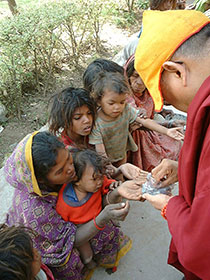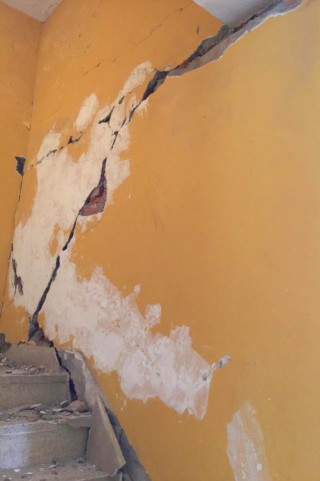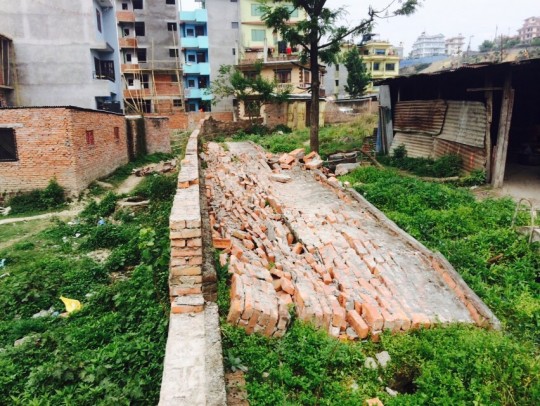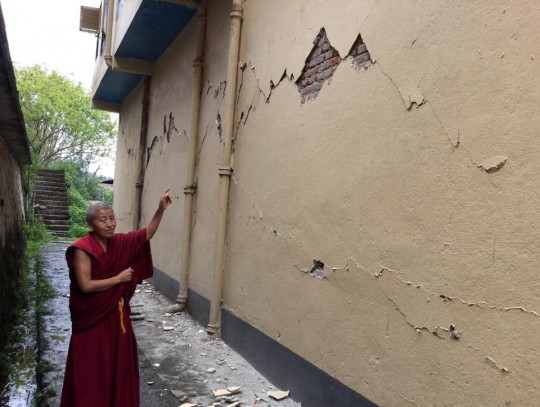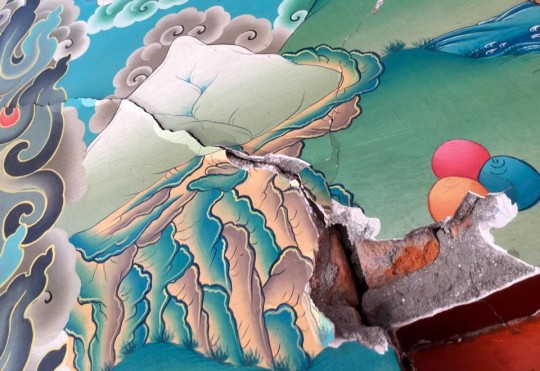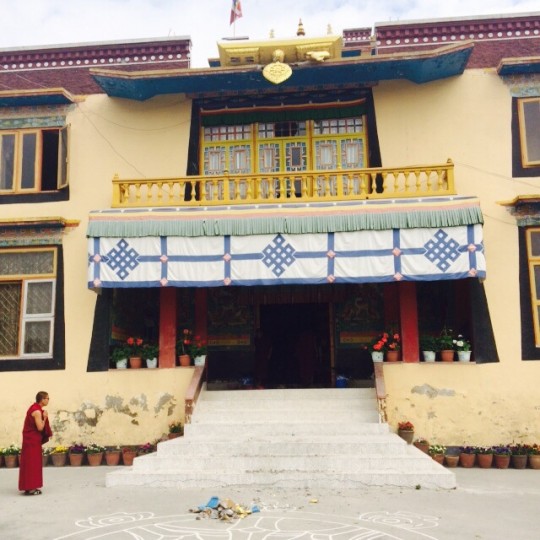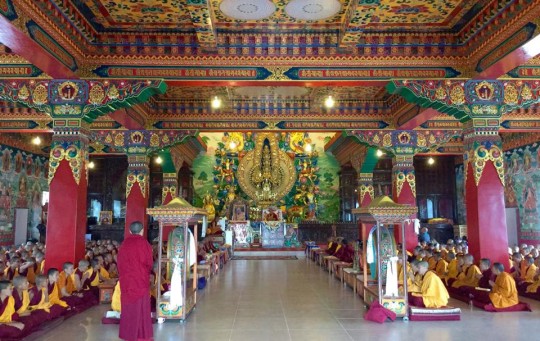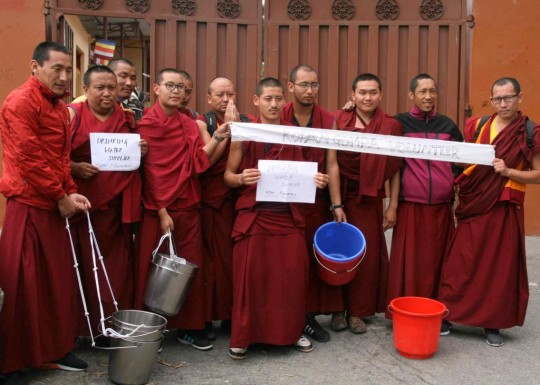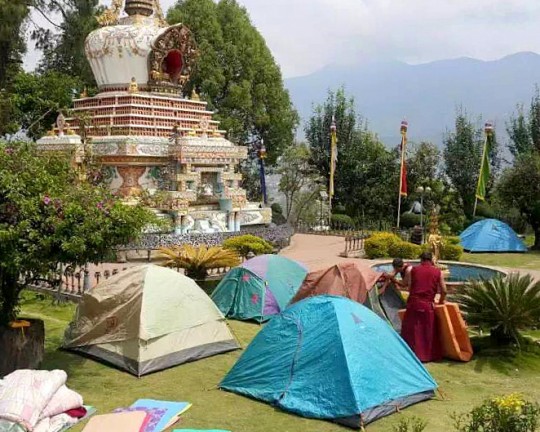- Home
- FPMT Homepage
Foundation for the Preservation of the Mahayana Tradition
The FPMT is an organization devoted to preserving and spreading Mahayana Buddhism worldwide by creating opportunities to listen, reflect, meditate, practice and actualize the unmistaken teachings of the Buddha and based on that experience spreading the Dharma to sentient beings. We provide integrated education through which people’s minds and hearts can be transformed into their highest potential for the benefit of others, inspired by an attitude of universal responsibility and service. We are committed to creating harmonious environments and helping all beings develop their full potential of infinite wisdom and compassion. Our organization is based on the Buddhist tradition of Lama Tsongkhapa of Tibet as taught to us by our founders Lama Thubten Yeshe and Lama Thubten Zopa Rinpoche.
- Willkommen
Die Stiftung zur Erhaltung der Mahayana Tradition (FPMT) ist eine Organisation, die sich weltweit für die Erhaltung und Verbreitung des Mahayana-Buddhismus einsetzt, indem sie Möglichkeiten schafft, den makellosen Lehren des Buddha zuzuhören, über sie zur reflektieren und zu meditieren und auf der Grundlage dieser Erfahrung das Dharma unter den Lebewesen zu verbreiten.
Wir bieten integrierte Schulungswege an, durch denen der Geist und das Herz der Menschen in ihr höchstes Potential verwandelt werden zum Wohl der anderen – inspiriert durch eine Haltung der universellen Verantwortung und dem Wunsch zu dienen. Wir haben uns verpflichtet, harmonische Umgebungen zu schaffen und allen Wesen zu helfen, ihr volles Potenzial unendlicher Weisheit und grenzenlosen Mitgefühls zu verwirklichen.
Unsere Organisation basiert auf der buddhistischen Tradition von Lama Tsongkhapa von Tibet, so wie sie uns von unseren Gründern Lama Thubten Yeshe und Lama Thubten Zopa Rinpoche gelehrt wird.
- Bienvenidos
La Fundación para la preservación de la tradición Mahayana (FPMT) es una organización que se dedica a preservar y difundir el budismo Mahayana en todo el mundo, creando oportunidades para escuchar, reflexionar, meditar, practicar y actualizar las enseñanzas inconfundibles de Buda y en base a esa experiencia difundir el Dharma a los seres.
Proporcionamos una educación integrada a través de la cual las mentes y los corazones de las personas se pueden transformar en su mayor potencial para el beneficio de los demás, inspirados por una actitud de responsabilidad y servicio universales. Estamos comprometidos a crear ambientes armoniosos y ayudar a todos los seres a desarrollar todo su potencial de infinita sabiduría y compasión.
Nuestra organización se basa en la tradición budista de Lama Tsongkhapa del Tíbet como nos lo enseñaron nuestros fundadores Lama Thubten Yeshe y Lama Zopa Rinpoche.
A continuación puede ver una lista de los centros y sus páginas web en su lengua preferida.
- Bienvenue
L’organisation de la FPMT a pour vocation la préservation et la diffusion du bouddhisme du mahayana dans le monde entier. Elle offre l’opportunité d’écouter, de réfléchir, de méditer, de pratiquer et de réaliser les enseignements excellents du Bouddha, pour ensuite transmettre le Dharma à tous les êtres. Nous proposons une formation intégrée grâce à laquelle le cœur et l’esprit de chacun peuvent accomplir leur potentiel le plus élevé pour le bien d’autrui, inspirés par le sens du service et une responsabilité universelle. Nous nous engageons à créer un environnement harmonieux et à aider tous les êtres à épanouir leur potentiel illimité de compassion et de sagesse. Notre organisation s’appuie sur la tradition guéloukpa de Lama Tsongkhapa du Tibet, telle qu’elle a été enseignée par nos fondateurs Lama Thoubtèn Yéshé et Lama Zopa Rinpoché.
Visitez le site de notre Editions Mahayana pour les traductions, conseils et nouvelles du Bureau international en français.
Voici une liste de centres et de leurs sites dans votre langue préférée
- Benvenuto
L’FPMT è un organizzazione il cui scopo è preservare e diffondere il Buddhismo Mahayana nel mondo, creando occasioni di ascolto, riflessione, meditazione e pratica dei perfetti insegnamenti del Buddha, al fine di attualizzare e diffondere il Dharma fra tutti gli esseri senzienti.
Offriamo un’educazione integrata, che può trasformare la mente e i cuori delle persone nel loro massimo potenziale, per il beneficio di tutti gli esseri, ispirati da un’attitudine di responsabilità universale e di servizio.
Il nostro obiettivo è quello di creare contesti armoniosi e aiutare tutti gli esseri a sviluppare in modo completo le proprie potenzialità di infinita saggezza e compassione.
La nostra organizzazione si basa sulla tradizione buddhista di Lama Tsongkhapa del Tibet, così come ci è stata insegnata dai nostri fondatori Lama Thubten Yeshe e Lama Zopa Rinpoche.
Di seguito potete trovare un elenco dei centri e dei loro siti nella lingua da voi prescelta.
- 欢迎 / 歡迎
简体中文
“护持大乘法脉基金会”( 英文简称:FPMT。全名:Foundation for the Preservation of the Mahayana Tradition) 是一个致力于护持和弘扬大乘佛法的国际佛教组织。我们提供听闻,思维,禅修,修行和实证佛陀无误教法的机会,以便让一切众生都能够享受佛法的指引和滋润。
我们全力创造和谐融洽的环境, 为人们提供解行并重的完整佛法教育,以便启发内在的环宇悲心及责任心,并开发内心所蕴藏的巨大潜能 — 无限的智慧与悲心 — 以便利益和服务一切有情。
FPMT的创办人是图腾耶喜喇嘛和喇嘛梭巴仁波切。我们所修习的是由两位上师所教导的,西藏喀巴大师的佛法传承。
繁體中文
護持大乘法脈基金會”( 英文簡稱:FPMT。全名:Found
ation for the Preservation of the Mahayana Tradition ) 是一個致力於護持和弘揚大乘佛法的國際佛教組織。我們提供聽聞, 思維,禪修,修行和實證佛陀無誤教法的機會,以便讓一切眾生都能 夠享受佛法的指引和滋潤。 我們全力創造和諧融洽的環境,
為人們提供解行並重的完整佛法教育,以便啟發內在的環宇悲心及責 任心,並開發內心所蘊藏的巨大潛能 — 無限的智慧與悲心 – – 以便利益和服務一切有情。 FPMT的創辦人是圖騰耶喜喇嘛和喇嘛梭巴仁波切。
我們所修習的是由兩位上師所教導的,西藏喀巴大師的佛法傳承。 察看道场信息:
- FPMT Homepage
- News/Media
-
- Study & Practice
-
-
- About FPMT Education Services
- Latest News
- Programs
- New to Buddhism?
- Buddhist Mind Science: Activating Your Potential
- Heart Advice for Death and Dying
- Discovering Buddhism
- Living in the Path
- Exploring Buddhism
- FPMT Basic Program
- FPMT Masters Program
- FPMT In-Depth Meditation Training
- Maitripa College
- Lotsawa Rinchen Zangpo Translator Program
- Universal Education for Compassion & Wisdom
- Online Learning Center
-
- Prayers & Practice Materials
- Overview of Prayers & Practices
- Full Catalogue of Prayers & Practice Materials
- Explore Popular Topics
- Benefiting Animals
- Chenrezig Resources
- Death & Dying Resources
- Lama Chopa (Guru Puja)
- Lama Zopa Rinpoche: Compendium of Precious Instructions
- Lama Zopa Rinpoche: Life Practice Advice
- Lama Zopa Rinpoche Practice Series
- Lamrim Resources
- Mantras
- Prayer Book Updates
- Purification Practices
- Sutras
- Thought Transformation (Lojong)
- Audio Materials
- Dharma Dates - Tibetan Calendar
- Translation Services
- Publishing Services
- Ways to Offer Support
- Prayers & Practice Materials
-
- Teachings and Advice
- Find Teachings and Advice
- Lama Zopa Rinpoche Advice Page
- Lama Zopa Rinpoche: Compendium of Precious Instructions
- Lama Zopa Rinpoche Video Teachings
- ༧སྐྱབས་རྗེ་བཟོད་པ་རིན་པོ་ཆེ་མཆོག་ནས་སྩལ་བའི་བཀའ་སློབ་བརྙན་འཕྲིན།
- Podcasts
- Lama Yeshe Wisdom Archive
- Buddhism FAQ
- Dharma for Young People
- Resources on Holy Objects
- Teachings and Advice
-
-
*If a menu item has a submenu clicking once will expand the menu clicking twice will open the page.
-
-
- Centers
-
- Teachers
-
- Projects
-
-
-
-
*If a menu item has a submenu clicking once will expand the menu clicking twice will open the page.
-
-
- FPMT
-
-
-
-
-
Anybody who dedicates their life to achieving lam rim realizations with the goal to liberate numberless beings from the oceans of samsaric suffering and to bring to enlightenment, this is what I regard as the most important thing in the world.
Lama Zopa Rinpoche
-
-
-
- Shop
-
-
-
The Foundation Store is FPMT’s online shop and features a vast selection of Buddhist study and practice materials written or recommended by our lineage gurus. These items include homestudy programs, prayers and practices in PDF or eBook format, materials for children, and other resources to support practitioners.
Items displayed in the shop are made available for Dharma practice and educational purposes, and never for the purpose of profiting from their sale. Please read FPMT Foundation Store Policy Regarding Dharma Items for more information.
-
-
FPMT News Around the World
1
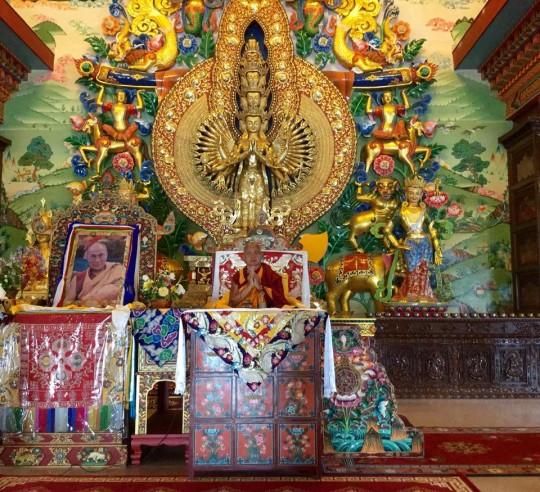
Lama Zopa Rinpoche offering prayers, blessings and teaching in the new gompa at Khachoe Ghakyil Nunnery, also know as the Kopan Nunnery, Nepal, April 30, 2015. Photo by Ven. Sarah Thresher. This was an important event for the nunnery to have Rinpoche enter their newly completed gompa, especially in light of the trauma of the earthquake and aftershocks.
Ven. Joan Nicell, a Canadian nun currently living at Kopan Monastery, shared this report of events at Kopan Monastery and Nunnery after the April 25 earthquake in Nepal. This report wraps up a week of blog posts on FPMT.org covering the earthquake and its aftermath.
Day 1
At noon on April 25, 2015 the earth swayed and shook at Kopan Monastery and across Nepal. The earthquake registered 7.8 on the Richter scale. At Kopan 40 or so frightened foreign visitors left their lunch and stumbled out of the dining room to the open ground of the stupa garden. More than 100 monks, who were also eating lunch on their Saturday off, soon joined them. Lama Zopa Rinpoche was carried on a bamboo chair down the two flights of stairs from his room above the main temple to the garden. Rinpoche took the opportunity to give an impromptu teaching on impermanence. Meanwhile, several monks and lay people returned to Rinpoche’s room to sop up the water from the many overturned offering bowls and pick up the statues and text that had been thrown from the altars.
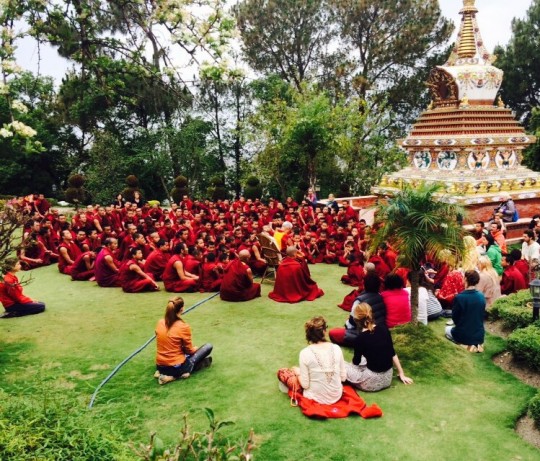
Lama Zopa Rinpoche leading prayers the day of the earthquake, Kopan Monastery, Nepal, April 25, 2015. Photo by Ven. Sangpo Sherpa.
In Kopan Nunnery the nuns quickly gathered in the open field between the many new buildings. One nun sleeping in her room above the old gompa watched in fear as her room shook and books and pots crashed to the ground. One of the deer on the roof of the old gompa fell and smashed to pieces on the gompa steps. The other deer and the Dharma wheel remained hanging precariously over the edge of the roof. Lay people from the surrounding houses soon began to join the nuns, many with small children.
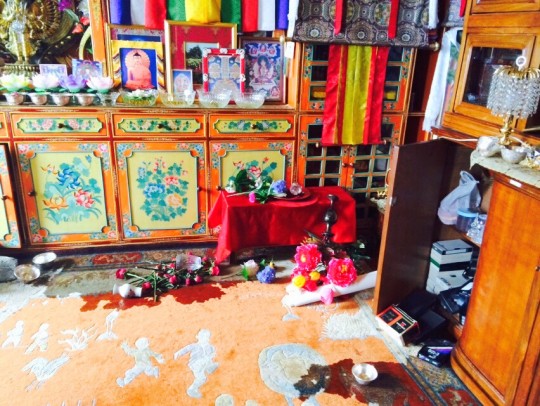
Spilled water bowls in Lama Zopa Rinpoche’s room, Kopan Monastery, Nepal, April 25, 2015. Photo by Ven. Sangpo Sherpa.
The aftershocks continued throughout the afternoon, often not more than 20 minutes between each one. Screams from the frightened people crowded into every available open area could be heard with each tremor. News began to arrive via phone of deaths and injuries throughout the country accompanied by warnings to remain outside. At Kopan, as evening approached, several small tents were quickly set up for Rinpoche, the geshes, older monks and Western nuns. A larger dormitory-like tent was erected for some of the foreign visitors. The younger monks and foreigners slept on camping mats under the open sky, while the youngest of the monks were sent to sleep in the gompa. The Kopan nuns spent the night wrapped in blankets and cloaks under the sky.

Tents set up after the earthquake, Kopan Monastery, Nepal, April 2015. Photo by Ven. Sarah Thresher.
Day 2
The next morning at Kopan was surreal, with Rinpoche sitting, apparently very relaxed and even sleeping, in the shade of a big tree surrounded by cross-legged foreigners doing their own prayers and practices for the earthquake victims. Young monks ran around, as young boys do, excited to have a day off. At 1 p.m. when the second big tremor hit (over 6 on the Richter scale), the atmosphere turned somber again as everyone quietly gathered around Rinpoche. Prayers were recited for those who had died and been injured. The monks set up more tents at Kopan and the nuns erected plastic tarps at the nunnery as everyone prepared for another night outside. Bright orange and blue plastic tarps could be seen popping up in every open space in the valley below Kopan.
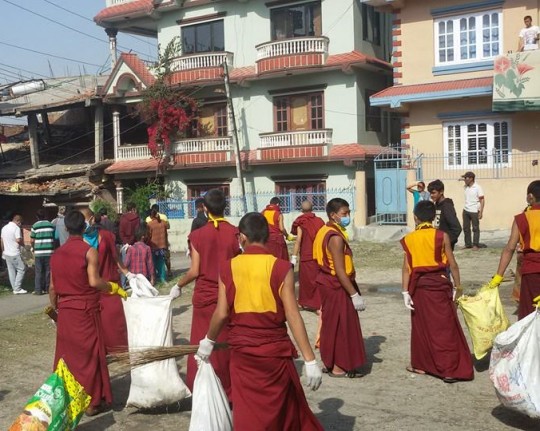
Kopan monks involved in efforts to clean up areas to prevent the spread of disease after the earthquake, Kathmandu, Nepal, May 1, 2015. Photo from Kopan Monastery School on Facebook.
Day 3-7
As the days are passing and news from around the country continues to worsen, “Kopan Helping Hands” is organizing truckloads of food and water to distribute to needy people in the city. The monks are also volunteering to clean up some of the tent cities that dot the city. Evening prayers with Rinpoche are an unscheduled but regular part of the day, most often in the garden but, when raining, in the main temple.
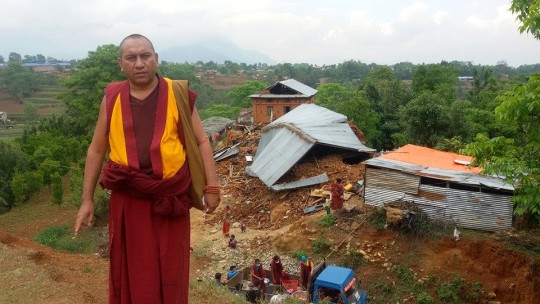
Ven. Nawang Thinley and other Kopan monks offering emergency relief, Nepal, April 30, 2015. Photo courtesy Nawang Thinley on Facebook.
Damage to Kopan Monastery
One of the buildings with the biggest damage is the Chenrezig Gompa, the temple where all the introductory courses for foreigners are normally held. The building appears to have shifted away from the embankment resulting in large cracks in the stairwell and outer walls. Both inside and outside large pieces of plaster have shattered on the floor revealing the bricks beneath. Fortunately the statues in the altar, many of them an important part of Kopan’s history, were not damaged.
The nearby accommodation block was also seriously damaged with a gaping hole in the back of one room and deep cracks in the walls in all the lower rooms and toilets.
One of the older brick buildings that houses the monks has extensive cracks beneath the cement beams in every room but is structurally sound. The nearby large accommodation block also has many cracks, especially in the rooms on the second floor. A brick railing around the rooftop room crashed to the ground; fortunately no one was injured.
The library and bookstore floors are covered in books that spilled to the floor. A week after the quake, it was deemed safe enough for a group of guests, nuns, and monks to begin the work of putting them back on the shelves.
Damage to Kopan Nunnery
The old gompa has been badly damaged. The walls around the building are cracked, a deer and the Dharma wheel remain dangling from the roof, some of the decorative cement victory banners fell to the ground, and windows are broken. Much of the boundary wall that surrounds the nunnery land collapsed, making it easy for anyone to enter the property. The interior walls of the new gompa have ugly cracks spoiling the beautiful artwork of the wall paintings. Externally the back wall has been damaged. The walls of the new, not yet finished, dining room also have many cracks. The new accommodation block also sustained some damage. It is not yet clear whether or not the old accommodation block has sustained structural damage. Strangely the old kitchen remained unharmed.
How to Help
Kopan Monastery and Nunnery will need financial help to repair damaged buildings and perhaps even tear down and rebuild the more badly damaged ones. For more up-to-date information check out their websites.
After today, we will post updates from Nepal after the earthquake to FPMT.org less frequently. For those interested in finding more FPMT-related news from Nepal, follow FPMT on Facebook.
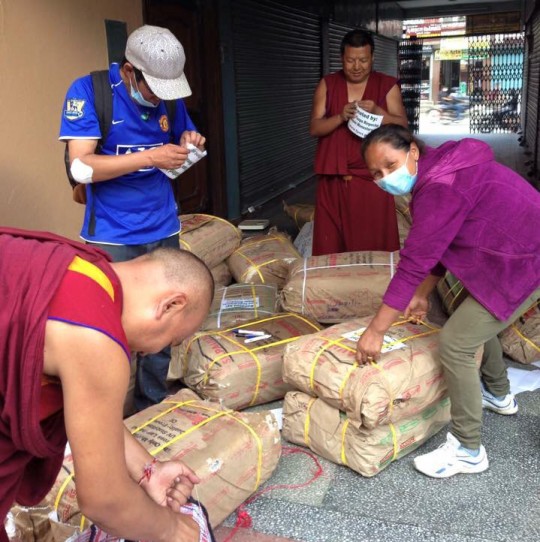
Helping prepare the emergency relief aid for Thame, May 1, 2015. Photo by Tara Melwani. The emergency relief is sponsored, in part, by FPMT’s Nepal Earthquake Support Fund. Five Kopan monks traveled with the suppies to manage their distribution, which an eyewitness on the ground described as “orderly.”
For updates and news from Kopan Monastery and Nunnery and other FPMT centers and projects in Nepal affected by the earthquake, visit our “Updates from Nepal after the Earthquake” page:
https://fpmt.org/nepal-earthquake/
To offer support to the Nepal Earthquake Support Fund visit:
https://fpmt.org/support/socialservices/
For “Prayers and Practice for Earthquake in Nepal,” see:
https://fpmt.org/edu-news/prayers-and-practices-for-earthquake-in-nepal/
You can receive an email daily digest of news from FPMT.org, including our updates from Nepal, by signing up at this address:
https://fpmt.us6.list-manage.com/subscribe?u=97e3ebb09472d09e0e699efd3&id=b248a1a45e
Mandala brings you news of Lama Zopa Rinpoche and of activities, teachings and events from nearly 160 FPMT centers, projects and services around the globe. If you like what you read on Mandala, consider becoming a Friend of FPMT, which supports our work.
- Tagged: khachoe ghakyil ling, kopan, kopan monastery, nepal earthquake, nepal earthquake support fund, thame
- 0
30
News from Kopan Nunnery
30 April 2015, 1 p.m. Kathmandu time
From Ven. Sarah Thresher:
Today, Tara Melwani, who is the Southeast Asia FPMT regional coordinator from Singapore, and myself went down to check on the Khachoe Ghaykil Nunnery also known as Kopan Nunnery. On the way, we passed the Kopan reception where Geshe Jinpa was coordinating Kopan relief efforts. He told us this morning Kopan sent out 1,500 packed lunches and 1,200 bottles of drinking water to the camps, along with two trucks and 30 monks to help collect garbage.
On the road from Kopan Monastery down to the nunnery, the only sign of the earthquake was the makeshift tents in every field. Apart from that, shops and small eating places are open and people are getting on with their lives.
When we arrived at the nunnery Khen Rinpoche Geshe Chonyi was there and the nuns were preparing for a visit by Lama Zopa Rinpoche this afternoon and an opening ceremony puja in the new prayer hall. Khen Rinpoche, who is the abbot of both the monastery and nunnery, pointed out the cracks all along two walls of the new prayer hall, the broken plaster and damaged paintings that had been newly completed. “Right now we are not even sure how to fix it,” he told us. “Some of the cracks look quite superficial, but they run deep into the building’s structure.”
There has been quite extensive damage to nunnery buildings and the nuns themselves have been sleeping outside under makeshift tents made of plastic and tarpaulin, or in the long open basement of a new construction of classrooms. Ani Shedrup, one of the senior nuns, took us on a tour of the damage. She explained that the earthquake struck around lunchtime on Saturday, which is a holiday for the nuns. Some of the nuns were in the small reception building, preparing a special lunch for Ösel Rinpoche and his party; some were in Boudha doing puja; others were memorizing, etc. There was even one small group of nuns down in Kathmandu doing puja in a nine-story building when the quake struck. Miraculously they survived and walked back. Nobody was injured.
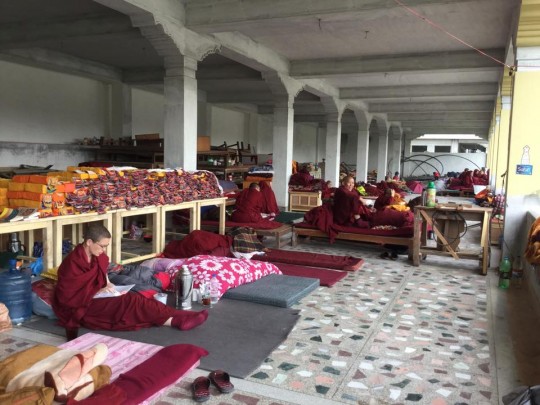
Nuns staying in an open basement of a building being constructed at Kopan Nunnery, Nepal, April 30, 2015. Photo by Ven. Sarah Thresher.
As we toured the buildings – the new prayer hall, the nuns accommodation block, the new kitchen, dining room, the incense factory, classrooms, etc. – there were cracks everywhere. Anila explained to us that every day they sweep up the debris, but every day more plaster falls down as the aftershocks widen the cracks. It’s very sad.
Most damaged – and likely beyond repair – is the old prayer hall. The deer and Dharma wheel hang from the roof; pillars are cracked and the plaster has fallen off. The cracks are extensive and it feels derelict. This is where the nunnery began and it is full of memories; everywhere is the reminder of Buddha’s teaching on impermanence.
Rinpoche will lead a puja at the nunnery this afternoon and hopefully the prayers will mark the beginning of a long project to restore and rebuild. Please give whatever support you can to those who are shouldering this responsibility; it is immense.

Lama Zopa Rinpoche opening and blessing the new gompa at Khachoe Ghakyil Nunnery, Nepal, April 30, 2015. Photo by Ven. Sarah Thresher.
Ven. Sarah shared photos from the opening and blessing of the beautiful new gompa at Khachoe Ghakyil Nunnery.
For the latest updates and news from Kopan Monastery and Nunnery and other FPMT centers and projects in Nepal affected by the earthquake, visit our “Updates from Nepal after the Earthquake” page:
https://fpmt.org/nepal-earthquake/
To learn more and offer support to the Nepal Earthquake Support Fund visit:
https://fpmt.org/support/socialservices/
For “Prayers and Practice for Earthquake in Nepal,” see:
https://fpmt.org/edu-news/prayers-and-practices-for-earthquake-in-nepal/
You can receive an email daily digest of news from FPMT.org, including our updates from Nepal, by signing up at this address:
https://fpmt.us6.list-manage.com/subscribe?u=97e3ebb09472d09e0e699efd3&id=b248a1a45e
Mandala brings you news of Lama Zopa Rinpoche and of activities, teachings and events from nearly 160 FPMT centers, projects and services around the globe. If you like what you read on Mandala, consider becoming a Friend of FPMT, which supports our work.
30
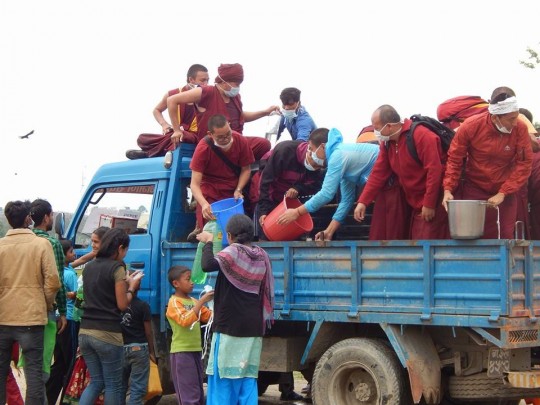
Day 4: Kopan Monastery monks help distribute drinking water, Kathmandu, Nepal, April 2015. Photo via Facbook, Kopan Monastery School.
Posted 30 April 2015, 10:18 p.m. Kathmandu
From Kopan Monastery staff:
Day five
We’ve come to know that food and water are needed at the hospital, which is full of sick people and their families living with little amounts of food and water. We prepared cooked meals and water bottles. Thanks to our cook and helpers, who made really good food and worked selflessly! Meanwhile, we prepared one more truck full of raw food. This will go to the remote villages around Shivapuri Hill.
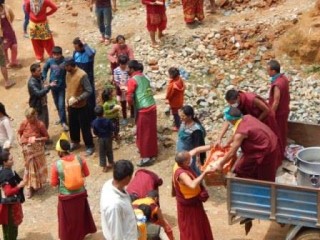
Day 5: Kopan Monastery monks distribute food aid packages to earthquake-affected villages, Nepal, April 2015. Photo via Facbook, Kopan Monastery School.
We drove our truck to Sinemangal Kathmandu Medical College, which we found very crowded people. We didn’t know where to begin. Thanks to Mrs. Sunita Panday (college manager) who helped us to distribute the food and water. Then we drove to Patan Hospital, Lagankhel. We saw the same situation and distributed the food and water. Thanks to the hospital which also offered meals to all the earthquake victims so that we did not need to cover all. We got information from someone who asked us to help at Chapa Gaon, where people remain hungry and homeless. We immediately drove with them to the area.
There is no proper road and one small village totally collapsed. It is interesting to know that no help reached here even after five days. We distributed what we had promised to come back tomorrow with food. We learned that we need to take rice, dal, oil, salt, etc. but there is no water shortage. As we came back home, we prepared packages for tomorrow.
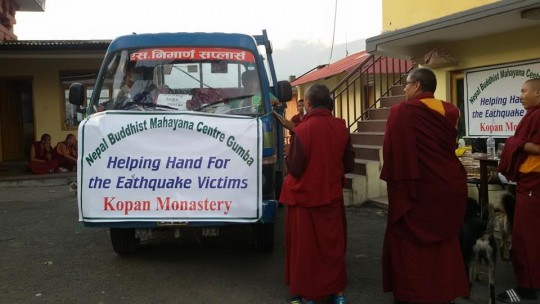
Day 5: Kopan Monastery helps provide relief for earthquak victims, Kopan, Nepal, April 2015. Photo via Facbook, Kopan Monastery School.
Posted 30 April 2015, 7:18 a.m. Kathmandu
From Kopan Monastery staff:
Day four
After breakfast, while our young monks assembled for morning prayers, we divided into two groups: one for cleaning and one for water supplies. The cleaning group was set up according to DSP suggestion. It was to cleaning the area where hundreds of people tented, advising and making people aware to keep the area clean or else there might be the possibility spreading many diseases.
We hired two trucks for water supply and set up 2,000-liter (528-gallon) tanks for each. Thanks to the Nepal government’s Kathmandu Water Supply Center for providing free water at this time.
The first load headed toward Tundi-khel where thousands of people live outside. We witnessed a hundred people rush toward the water tank as soon as they saw us and heard that there could be drinking water. We distributed 6,000 liters (1,585 gallons) of water and more than a hundred boxes of face masks.
The second load of water was distributed around the Swyambunath area; the third load was distributed around the Kopan area.
At night we distributed food and water bottles in and around the hospital. We found many asking for soap, Dettol and iodine.
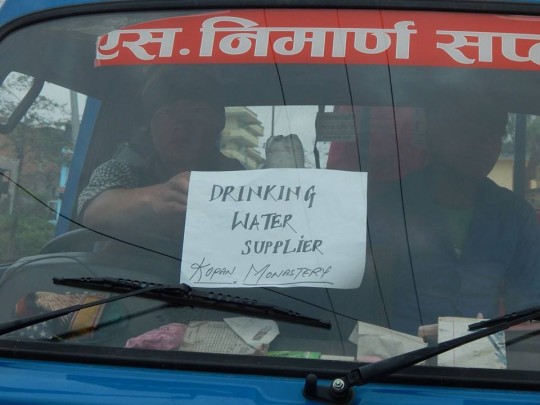
Day 4: Kopan Monstery monks and staff help bring drinking water to earthquake-affected people, Nepal, April 2015. Photo via Facbook, Kopan Monastery School.
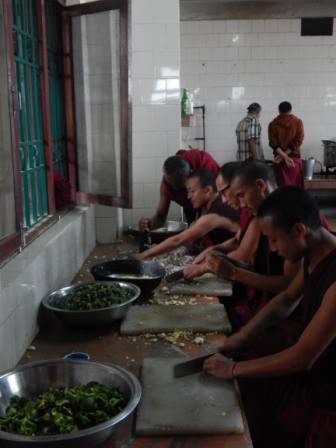
Day 5: Kopan Monastery monks and stuff help prepare food aid for earthquake victims, Kopan, Nepal, April 2015. Photo via Facbook, Kopan Monastery School.
Posted 30 April 2015, 7:18 a.m. Kathmandu
From Kopan Monastery staff:
Day three
Day three started with a pretty good morning. But we can’t make any conclusions on what really we need to do. Since most ways of communication is not so good, we really don’t know what kind of help people need. We went to search around the affected areas. In the meantime, we decided to help prepare food items through NBF (Nepal Buddhist Federation). A team was set up and sent to the NBF center.
While we’re looking around, we learned that water is what they really needed. So, as we came back to monastery, we made a decision to supply water and clean up the affected areas.
For the latest updates and news from Kopan Monastery and other FPMT centers and projects in Nepal affected by the earthquake, visit our “Updates from Nepal after the Earthquake” page:
https://fpmt.org/nepal-earthquake/
To learn more and offer support to the Nepal Earthquake Support Fund visit:
https://fpmt.org/support/socialservices/
For “Prayers and Practice for Earthquake in Nepal,” see:
https://fpmt.org/edu-news/prayers-and-practices-for-earthquake-in-nepal/
You can receive an email daily digest of news from FPMT.org, including our updates from Nepal, by signing up at this address:
https://fpmt.us6.list-manage.com/subscribe?u=97e3ebb09472d09e0e699efd3&id=b248a1a45e
Mandala brings you news of Lama Zopa Rinpoche and of activities, teachings and events from nearly 160 FPMT centers, projects and services around the globe. If you like what you read on Mandala, consider becoming a Friend of FPMT, which supports our work.
29
Helping in Diverse Ways
29 April 2015, 8 p.m. Kathmandu time
From Ven. Sarah Thresher:
Teachings canceled today [at Kopan]. Most people went down to help in diverse ways: distributing food in Bhaktapur, moving rubble, collecting garbage. In Durbar Square they found one person still alive as well as many bodies. They say the energy of everyone working together – Westerners, Nepalis, etc. was very inspiring.
27 April 2015, evening
From Phil Hunt, coordinator of the Animal Liberation Sanctuary at Kopan Monastery:
… The afternoon field trip [to check on animals] was delayed due to more rain. This is supposed to be the dry season with increasing temperatures and dust storms. Yet Kathmandu has had many alternate days of rain this month already and more to come. The roads become muddy and slippery and the moisture weakens buildings where new faults lie. Locals are worried that the real rain coming during the monsoon will result in more collapses of otherwise strong looking buildings.
Finally a let up in the weather allowed Pema [manager of the Animal LIberation Sanctuary] and myself to go out to survey the Boudha area – the heart of Tibetans in Kathmandu. The majestic stupa is normally radiating calm amid swaying lines of fluttering prayer flags. Now the golden apex is askew with deep cracks on several sides and the prayer flags have fallen. The bustling circuit around the stupa is still very quiet with few shops and cafes open and even fewer people circumambulating the holy object. Tourists are almost non-existent. However, the boom-boom of Tibetan Buddhist drums comes from a monastery as the monks return to buildings to do prayers.
The “stupa dogs” that we saw had no injuries. Pema gave the pigeons some food, as did some passing monks.
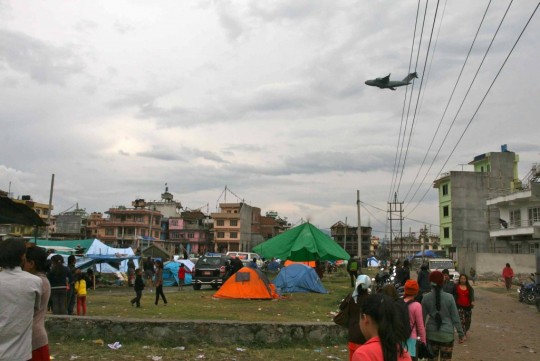
Tent city where Animal Liberation Sanctuary manager Pema and his family are camped out, Kathmandu, Nepal, April 27, 2015. Photo by Phil Hunt.
South of the stupa and closer to the airport is a large makeshift tent city. Thousands of people are sheltering here out of the adjacent high-rise apartments of the area. Most shops are still shut and people are still making do with what they brought with them. It will still be another night or two before they feel comfortable to return to their homes, although, thankfully, now the atmosphere is much more cheerful. People I spoke to felt more relaxed and that the worst of the danger was over. …
Water will be the biggest concern and it always is in short supply at the best of times. At Kopan Monastery a meeting was called for all international visitors. People who could leave were encouraged to head to a functioning hotel but to wait 2-3 days before attempting the airport, where long queues and chaotic conditions ruled. Scheduled flights were disrupted to allow for essential aid flights. The roar of the big military planes is both chilling and heartening in equal measure. For those guests remaining [at Kopan], water conservation is the rule. One of the large water tanks is broken and the daily pumping of water to keep this monastery on top of the hill running can only be done with the twice-daily dose of generator power. ‘Please don’t flush’ was the request.
After our visit we returned to check on the animals [at the sanctuary]. Pema finished the round of daily wound treatment and medicines, particularly for Kalden the calf who is almost fully recovered from terrible wounds back in January when we were notified of his near-death state. He has become a great friend to Christmas [the cow] who generally can’t socialize with the other cows as he has a congenital condition that restricts his mobility.
We double check food supplies. There is enough for the cows for 10-14 days, which is hopefully enough to get through the shortage that will ensue soon. The goats’ stores were restocked the day before the earthquake and will be adequate for at least a month. Beyond that the price may be affected, but hopefully supplies will be available.
Tomorrow we will head out to worse affected areas so that we can provide assistance to any injured animals.
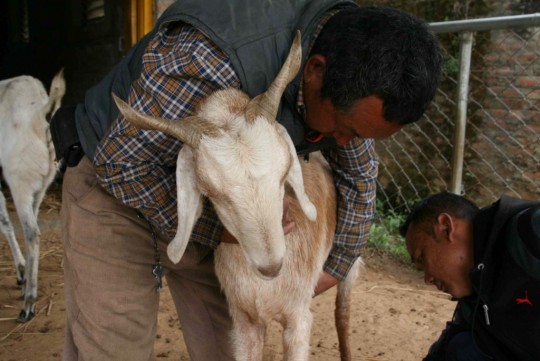
Samadhi the goat at the Animal Liberation Sanctuary being held by the caretaker (who’s from Tsum) while Pema (the manager) treats him, Kathmandu, Nepal, April 28, 2015. Photo by Phil Hunt.
To read more from Animal Liberation Sanctuary coordinator Phil Hunt, visit the Tree of Compassion news blog.
For the latest updates and news from Kopan Monastery and other FPMT centers and projects in Nepal affected by the earthquake, visit our “Updates from Nepal after the Earthquake” page: https://fpmt.org/nepal-earthquake/
To learn more and offer support to the Nepal Earthquake Support Fund visit:
https://fpmt.org/support/socialservices/
For “Prayers and Practice for Earthquake in Nepal,” see:
https://fpmt.org/edu-news/prayers-and-practices-for-earthquake-in-nepal/
You can receive an email daily digest of news from FPMT.org, including our updates from Nepal, by signing up at this address:
https://fpmt.us6.list-manage.com/subscribe?u=97e3ebb09472d09e0e699efd3&id=b248a1a45e
Mandala brings you news of Lama Zopa Rinpoche and of activities, teachings and events from nearly 160 FPMT centers, projects and services around the globe. If you like what you read on Mandala, consider becoming a Friend of FPMT, which supports our work.
28
FPMT’s Activities in Nepal
The strong connection between the international FPMT community and Nepal cannot be understated. After all, Kopan Hill is where it all started. After receiving teachings from Lama Yeshe and Lama Zopa Rinpoche during the first Kopan courses in the early 1970s, inspired students spread across the globe, starting FPMT centers and sharing Dharma. But FPMT’s work inside Nepal also has grown and expanded.
Currently there are several FPMT centers in Nepal: Kopan Monastery and Nunnery; the Himalayan Buddhist Meditation Centre, which is the “city center” located in Kathmandu; Ganden Yiga Chozin Buddhist Meditation Centre, located in Pokhara; and Lawudo Gompa and Retreat Centre, which is in the Solu Khumbu district that includes Mount Everest. In addition, Kopan Monastery oversees several projects in Nepal, including the Animal Liberation Sanctuary in Kathmandu; Mu Gompa and Rachen Nunnery, both in the remote Tsum Valley; and Thubten Shedrup Ling Monastery in Solu Khumbu.
Early reports from Kathmandu, Pokhara, Tsum and Solu Khumbu indicate that, in general, people and animals are doing OK given the circumstances and some buildings have experienced structural damage. We will share more detailed reports and news from these different centers and projects as they become available.
To share more about FPMT’s involvement in Nepal, Mandala has posted the story “Nepal: ‘The Most Holy Place in the World,’” from Mandala‘s January-March 2013 issue. Here’s how the story begins:
“[Nepal] is really the most holy place in the world,” Lama Zopa Rinpoche said at a 2007 talk in Kathmandu on the “Value of Meditation and Pilgrimage for Nepal.” “Guru Shakyamuni Buddha took birth in Nepal, and not only that, so many great yogis who achieved enlightenment were born in Nepal. They practiced and achieved the complete path to enlightenment, the path that Buddha has taught. … So Nepal is unbelievable, such a precious holy place.” …
You can read the complete article as a PDF. From that same issue, you can see photos of FPMT activities in Nepal.
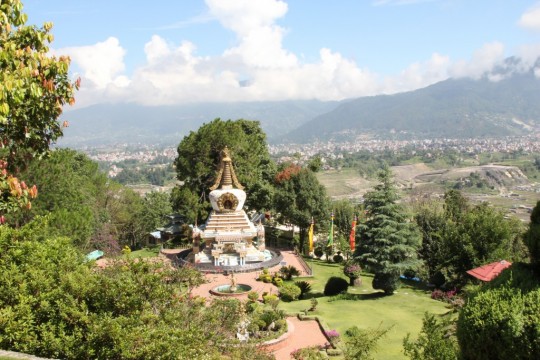
Geshe Lama Konchog Stupa at Kopan Monastery, Nepal, June 2011. Photo by Ven. Roger Kunsang.
For the latest updates and news from Kopan Monastery and other FPMT centers and projects in Nepal affected by the earthquake, visit our “Updates from Nepal after the Earthquake” page: https://fpmt.org/nepal-earthquake/
To learn more and offer support to the Nepal Earthquake Support Fund visit:
https://fpmt.org/support/socialservices/
For “Prayers and Practice for Earthquake in Nepal,” see:
https://fpmt.org/edu-news/prayers-and-practices-for-earthquake-in-nepal/
Mandala brings you news of Lama Zopa Rinpoche and of activities, teachings and events from nearly 160 FPMT centers, projects and services around the globe. If you like what you read on Mandala, consider becoming a Friend of FPMT, which supports our work.
- Tagged: nepal, nepal earthquake
- 0
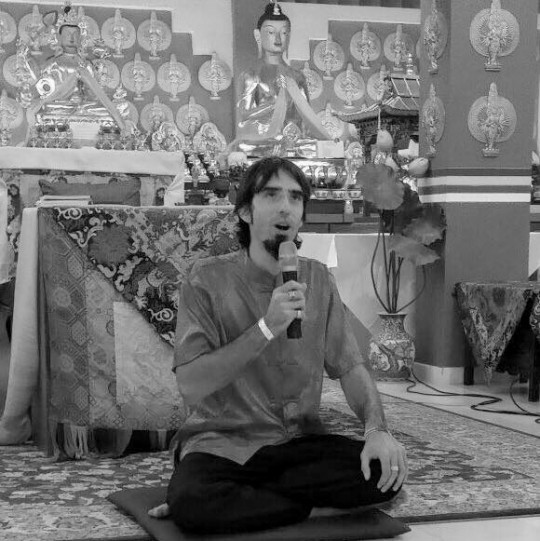
Tenzin Ösel Hita, Losang Dragpa Centre, Sengalor, Malaysia, February 2015. Photo courtesy of Ldc Fpmt Facebook.
On February 19, Tenzin Ösel Hita, the recognized reincarnation of FPMT founder Lama Yeshe, made a surprise visit to Malaysian center Losang Dragpa Centre to participate in its Guru Puja for Losar, Tibetan New Year. Just before the puja began, Ösel gave a short talk, which was transcribed by Carolyn Chan and edited by Yeo Puay Huei and Mandala for publication on FPMT.org:
“I just wanted to mention something quickly. The prayers that you are reciting refer to emptiness. I read somewhere not so long ago that quantum mechanics actually says 99.999% of atoms are empty. When we talk about material things, that which we can really touch or is tangible is only 0.001% of the atom. This means that if only the tangible parts of all the atoms of human beings were put together, all 7 billion humans would fit in a single sugar cube. Can you imagine that? Scientists are saying that all 7 billion humans could fit in a sugar cube. That is how ’empty’ we are.
“It is very funny how in this age, spirituality and quantum mechanics are coming together. Their paths have finally crossed. We are living in an age, a very, very big crystal age where thousands of years have passed and people have evolved a little bit. Times have changed: science has evolved, spirituality has evolved, but people are not ready for this kind of information.
“Three thousand years ago in Egypt, there was a pharaoh called Akhenaten. He started a revolution because he could not agree that there were many gods. He tried to explain to the people that the real god is within yourself. You possess the path within yourself. He was way ahead of his time. People did not understand. People were not prepared for that. So there was a huge revolution. Now here, 3,000 years later, we are actually ready for this kind of thinking. We have passed the Dark Ages, we went through the Middle Stone Age, we have been through World Wars. Now, finally people have the means to see all of these and learn from past mistakes. So, we are very lucky to be here at this age, today, everyday; this moment is very lucky. Of course, we think of the time as it is. Time has changed as it is.
“When talking about spirituality, we say that time is precious. We are here, with the precious human rebirth, possibly only once because they say human rebirth is like a turtle which comes up from the ocean bed only once every 100 years. In that vast ocean is a floating ring and this turtle comes up only once every 100 years. What are the chances of it placing its head through that ring? That is how difficult it is to get the precious human rebirth. That is the metaphor Tibetan Buddhism gives us to understand how lucky we are. This is something for us to cherish all the time.
“But then, we live in a society where the education system teaches us always to cherish ourselves and to think about ourselves, ‘me, me, me,’ right ? Capitalism is based on that. If people stop thinking like that, capitalism will fall apart. So, I am not saying this is good or bad, I am only saying it is good to be aware of this. Because the moment we stop only cherishing ourselves, we can actually start cherishing other people. When it really happens, it really starts feeling good. If everybody did that, thinking about the person next to you before you think about yourself, what a beautiful, lucky place. There will be no war, no famine, no hardship. You should really think about this and check it out. The more you think about yourself, the more you are going to suffer. If you think about the person next to you more than yourself, all you have is happiness. Your well-being will be linked to the universe, linked to karma and linked to human mind. Buddhism says this, so I do not have to say it. All of you know it. I think this important point should be put into practice and not just doing meditation or reading a book or coming to a puja, although these are also very good in making imprints and keeping us on the right path.
“The most important moment is when you put this cherishing others into practice, then it is like the phrase, ‘When the shit hits the fan,’ it spreads everywhere; it’s a strong metaphor! Keep the middle path. Think about the other person more than yourself. Even if you are suffering, forget about that. Think about the person next to you. For me, it is very easy to say, but very difficult to do. I also have a lot of suffering, difficulties and many frustrations. When these happen, I would do my best to think about the other person. But even then, it is so hard. After I make all the mistakes and mess up everything, I sit down and think, ‘Ah! I wish I had thought about it before. Now it is too late.’ Still, you can learn from your mistakes and slowly, slowly make an effort to be a better person and try to make the person next to you happier. This is my advice from my experience and difficulties that I have gone through. We are all going through this in the same way. So it is not like I am speaking and you think I am enlightened – blah, blah, blah – because I am not. (Laughter) I am of the worst quality.
“You know we cannot change the world, but what we can do is change ourselves. And that is the first step. So, we focus on that, OK? That’s the first step.”
Find a short video excerpt taken from this talk on YouTube, made available by Lama Yeshe Wisdom Archive.
The Big Love Fund supports Ösel‘s educational endeavors. You can follow news and updates about Ösel on the Ösel Hita news feed.
Mandala brings you news of Lama Zopa Rinpoche and of activities, teachings and events from nearly 160 FPMT centers, projects and services around the globe. If you like what you read on Mandala, consider becoming a Friend of FPMT, which supports our work.
- Tagged: losang dragpa centre, tenzin osel hita
- 0
20
News from Milarepa Center
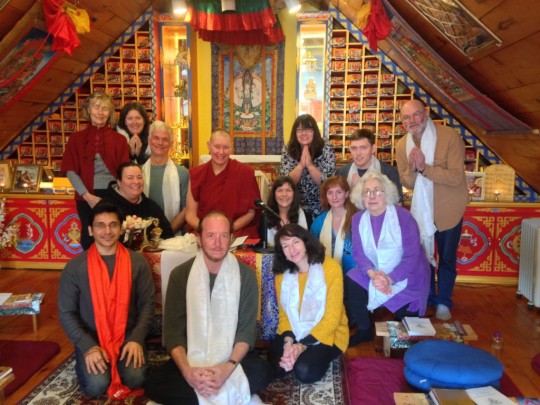
Ven. Tenzin Chogkyi led a three-day retreat on the bodhisattva vows, Milarepa Center, Vermont, January 2015. Photo courtesy of Milarepa Center.
“During the past few months Milarepa Center has had the honor of hosting an array of teachers that have benefited the Northeast Kingdom of Vermont in the United States greatly,” said office assistant Tommy Nimrod. “Geshe Konchog from Florida visited in November and held our concentration with the seven-point mind training. Members from Tubten Kunga Center, Geshe Konchog’s place of residence, flew in to attend a four-day Medicine Buddha retreat. Geshe-la’s last teaching left us with a unique representation of Mount Meru, using fruits from the kitchen.
“Transitioning into the holiday spirit, it was only appropriate for Ven. Tenzin Chogkyi to deck the halls with a Big Love day retreat. Ven. Chogkyi also led a beautiful five-day New Year’s Vajrasttava retreat. We ended the retreat by letting biodegradable lanterns, decorated with mantras and positive thoughts for the new year, into the crisp, winter night. In January, Ven. Chogkyi also led a three-day bodhisattva vows retreat which gave insight into the origination of the vows and how to implement them in daily life. She finished her teachings with a visit to the Kellogg Public Library in Montpeliar, the capital of Vermont, and spoke about dealing with emotions.
“At the end of January, director Felicity and kitchen manager Devon visited Land of Medicine Buddha for a delightful Foundation Service Seminar and the FPMT North American Regional Meeting. Felicity and Devon had a wonderful time learning more about the FPMT and exploring ways to keep a strong connection to Lama Yeshe and Lama Zopa Rinpoche. They loved connecting with the FPMT sangha from across the United States, Canada, and Mexico.
“In the upcoming Tibetan New Year we hope to continue to actualize the mission of FPMT in ‘creating a harmonious environment and helping all beings develop their full potential of infinite wisdom and compassion.’ We hope to see you at Milarepa Center soon for a personal or a group retreat. We are looking forward to serving you.”
Mandala brings you news of Lama Zopa Rinpoche and of activities, teachings and events from nearly 160 FPMT centers, projects and services around the globe. If you like what you read on Mandala, consider becoming a Friend of FPMT, which supports our work.
- Tagged: milarepa center
- 0
16
A New Era of Mandala Magazine
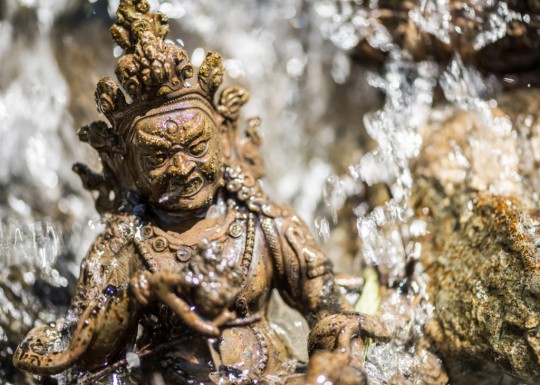
Detail of an outside fountain at Kachoe Dechen Ling, Aptos, California. Photo by Chris Majors.
Long gone are the days when we only received news of Lama Zopa Rinpoche and the FPMT organization through the mail. Between blog posts, Mandala’s expanded online features and social media like Facebook, engaged FPMT students around the world have countless photos and updates at their fingertips, shared sometimes as they happen. In response to this tremendous growth and availability of digital media, Mandala magazine is being reimagined.
Mandala has taken different forms over the three decades that it has been published. In June 2015, we unveil the newest, and we hope a very timeless and beautiful, version of Mandala!
The redesigned Mandala magazine will be published twice a year, in June and December, containing stories and teachings tailored to best make use of print media’s capacity for sharing quality, long-form pieces, thoughtful interviews and sharp, high-resolution photos. We are increasing the number of pages of each issue and updating the magazine’s design in order to create an enduring publication that students will want keep and read over again. We also will be publishing special Mandala ebooks, which will share some of the best stories from Mandala’s archive. Mandala’s first ebook will be available in September 2015.
In the July-December 2015 issue*, published June 16, 2015, readers can look forward to authentic and timeless teachings from Lama Zopa Rinpoche and Lama Yeshe, an in-depth feature on preparing for death, a profile of the profoundly compassionate Khunu Lama Rinpoche and much more.
To receive Mandala, become a Friend of FPMT supporter at the e-Friends level or higher. By joining Friends of FPMT, not only are you supporting the communications and education work of FPMT’s International Office, you receive Mandala magazine, Mandala’s new ebooks, and free access to Online Learning Center courses, FPMT Education practice and study materials and ebooks by Lama Zopa Rinpoche and Lama Yeshe. For more details and to join as a Friends supporter, see our Friends of FPMT page.
While you are waiting for the next issue, please take a look at Mandala’s expanded online publishing, which includes a new feature story every month. In this month’s feature, read the story of how FPMT student Tai Vautier helped develop FPMT’s microfilm mantras for filling prayer wheels, stupas and other holy objects. In case you missed March’s feature, “Bringing Dharma into the Corporate World,” Potential Project director Rasmus Hougaard talks with Mandala about how they are training corporate employees to be more kind and clear-minded with “Dharma in disguise.”
To receive daily emails from FPMT.org, digesting the day’s blog post, sign up on our news page. If daily email is too much, consider receiving the FPMT eNews, our monthly newsletter with updates from Lama Zopa Rinpoche, FPMT International Office and information on transitions and opportunities at the 160 FPMT centers, projects and services around the world.
*As part of our transition, we are forgoing the April-June 2015 issue.
Mandala brings you news of Lama Zopa Rinpoche and of activities, teachings and events from nearly 160 FPMT centers, projects and services around the globe. If you like what you read on Mandala, consider becoming a Friend of FPMT, which supports our work.
- Tagged: friends of fpmt, mandala, new mandala
- 0
13
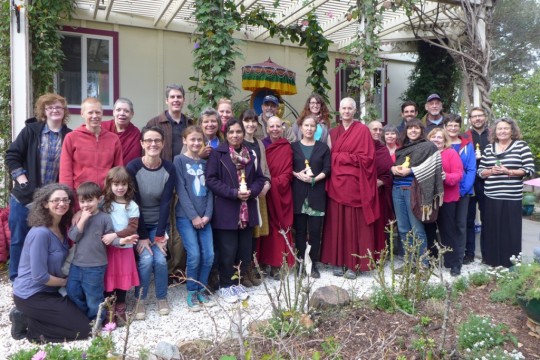
Foundation Service Seminar attendees during visit to Kachoe Dechen Ling, Aptos, California, January 2015. Photo by Laura Miller.
By Laura Miller, Mandala managing editor
In late January, I had the pleasure to be among the more than 40 people who attended the FPMT Foundation Service Seminar held at Land of Medicine Buddha (LMB) near Santa Cruz, California. The five-day seminar brought together staff and dedicated volunteers from several FPMT centers, projects and services in North America and Mexico. In addition to sessions focused on the worldwide efforts of FPMT, we spent time developing skills in speaking kind words, resolving conflicts, avoiding burnout and turning all aspects of working at a center into authentic Dharma practice. Ven. Drimay, a resident Sangha member at Land of Medicine Buddha, and Drolkar McCallum, coordinator for FPMT North America, skillfully facilitated the instructive sessions.
On one day, we had an afternoon field trip, which included an inspiring visit to Lama Zopa Rinpoche’s house, Kachoe Dechen Ling. After Ven. Holly Ansett led us on a tour of the house, many commented on how incredible and mind-blowing it was to see all the beautiful holy objects, altars and offerings throughout the house and gardens. Ven. Tsering, a Kopan monk who lives at the house and is writing out the Prajñaparamita Sutra in gold, showed us his beautiful work and talked about his process. And Ven. Anet baked delicious cakes that accompanied a relaxed tea break on the back deck. After leaving Rinpoche’s house, we watched a lovely sunset over the Pacific Ocean on a nearby beach and had an informal and friendly dinner at a local vegetarian restaurant.
Another highlight of the seminar was an evening of stories about FPMT founder Lama Yeshe. Robbie Solick, Jon Landaw and Karuna and Pam Cayton took turns sharing memories of some of Lama Yeshe’s incomparable qualities like kindness, humor and wisdom. The informal program of stories was more than a nostalgic walk down memory lane, it was a transmission of FPMT Wisdom Culture that palpably energized the room and the rest of the meeting.
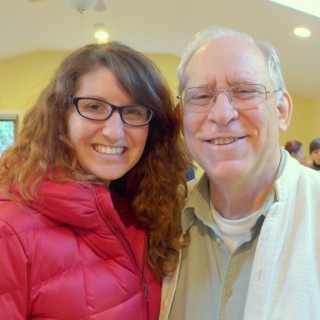
Felicity Keeley, director of Milarepa Center, with Jon Landaw, Land of Medicine Buddha, January 2015. Photo by Laura Miller.
Land of Medicine Buddha was a generous and accommodating host for the seminar and the FPMT North America Regional Meeting that followed. LMB director Denice Macy gave a tour of the center’s extensive grounds, which has many prayer wheels, incredible artwork and holy objects, and the amazing Mahabodhi Stupa that is being built.
The two-day FPMT North America Regional Meeting, which followed the seminar, was attended by 30 people, representing 17 centers, projects and services in the United States and Canada and one person from Mexico! FPMT Education Services director Tom Truty attended and led an engaged discussion on possible updates to the Discovering Buddhism program and other Education Services initiatives. Other agenda points included fundraising, good governance and updates from the 2014 CPMT meeting.
“I felt that the most significant and important thing accomplished at the Foundation Service Seminar and the FPMT North America Regional Meeting was a sense of community and the realization that all center, projects, services and study groups are facing very similar problems and challenges,” Drolkar McCallum told Mandala. “By coming together, supporting each other and sharing information and problem solving techniques we can inspire each other to continue our amazing work. Everyone came away from the seminar and meeting with a better understanding and sense of Rinpoche’s large mandala and the realization that we are not alone in our work, that there is a fabulous FPMT family to inspire us and a local regional group to help every step of the way. People left refreshed with renewed sense of purpose and armed with information and the enthusiasm to continue work for all sentient beings. Service is our practice!”
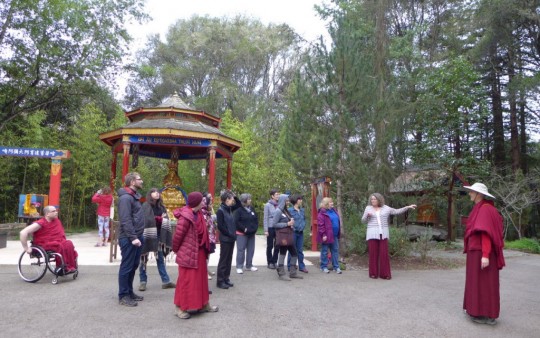
Denice Macy leads some Foundation Service Seminar participants on a tour of Land of Medicine Buddha, California, January 2015. Photo by Laura Miller.
Mandala brings you news of Lama Zopa Rinpoche and of activities, teachings and events from nearly 160 FPMT centers, projects and services around the globe. If you like what you read on Mandala, consider becoming a Friend of FPMT, which supports our work.
- Tagged: foundation service seminar, fpmt north america, kachoe dechen ling, land of medicine buddha
- 0
9
Update on Maitreya Buddha Kushinagar Project
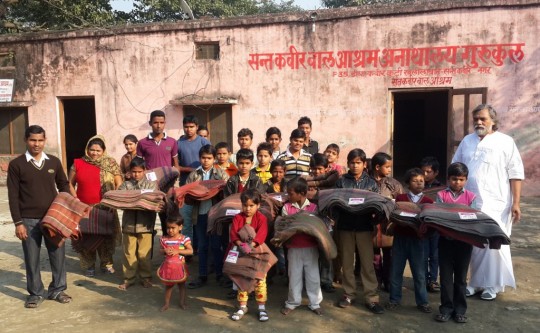
During the winter 2014 months, Maitreya Buddha Kunshinagar Project distributed thick blankets to various institutions, including orphanages, India, 2014. Photo courtesy of Maitreya Buddha Kushinagar Project.
The Maitreya Buddha Kushinagar Project, a project to build a very large statue of Maitreya Buddha in Kushinagar, India, continues to make steady progress.
In December 2013, the State Government of Uttar Pradesh commemorated the project with a Foundation Stone Laying Ceremony, attended by Lama Zopa Rinpoche and senior Uttar Pradesh officials.
The project is currently completing formalities with the state government. A key part of these was the submission by Maitreya Project Trust of a detailed project report. This was submitted to the government in February 2015. After what is hoped to be a final meeting, the Maitreya Buddha Kushinagar Project anticipates taking possession of 170 acres of land within a few weeks.
“170 acres is an enormous area,” long-time FPMT student Peter Kedge, who is involved with the project, told Mandala in February. “The land is adjacent to the Buddha Shakyamuni Paranirvana Temple and Shrine, and it borders on three sides the Ramabhar Stupa, the site of Buddha Shakyamuni’s cremation.”
Preliminary master planning of the site has begun, and the social work aspect of the project is already underway. Last year, a mobile health clinic was purchased, and it has traveled to local villages to provide primary healthcare education in aspects of primary health care and sanitation.
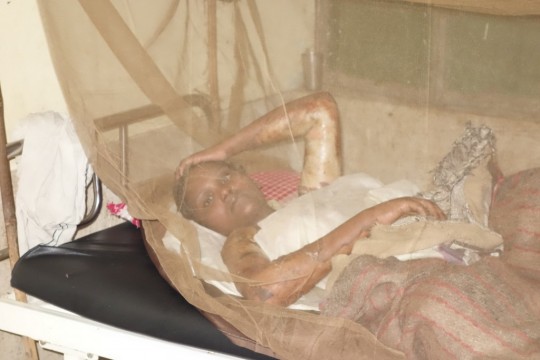
Mosquito nets donated by Maitreya Buddha Kushinagar Project help protect healing patients, India, 2014. Photo courtesy of Maitreya Buddha Kushinagar Project.
In the summer of 2014, mosquito nets and information on airborne disease control were distributed. In addition, during part of the winter, mosquito nets were being given to hospitals with burn wards to protect patients healing from burns. Burn accidents, especially among children, occur more often during cold months due to open fires in the home. The nets are set up around patients with open wounds to protect them from flies and mosquitos that may be in the hospital itself.
Over the recent winter months, the project distributed 2,400 high quality heavy wool blankets in three villages near the project, as well as to homeless people, street sleepers, beggars, a leper colony, orphanages, and widows homes. Many blankets were distributed to hospital patients and their families who have to stay in and around hospitals to care for their them.
Now that the weather is becoming warmer, the project plans to begin distributing mosquito nets again.
In 2014, Lama Zopa Rinpoche through the Lama Zopa Rinpoche Bodhichitta Fund offered US$16,000 towards the project’s social service work.
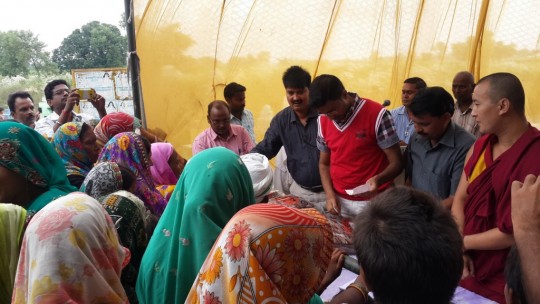
Maitreya Buddha Kushinagar Project workers distribute mosquito nets, India, 2014. Photo courtesy of Maitreya Buddha Kushinagar Project.
The project’s team is optimistic about their progress. According to Peter, there is a great team in India and there are plans to enlarge the team as soon as the project takes possession of the land as there will be a huge amount of work to do. Boundaries will have to be established and fenced; and on-site infrastructure, including roads, power, water, communications and facilities for a site office, and site security have to be set up.
There are plans to move the 24-foot [7-meter] Maitreya Buddha statue currently on the Maitreya Project Bodhgaya land to the land in Kushinagar. The installation of the statue will provide a temporary focal point for visitors, as well as a site for pujas, ceremonies, teaching, and meditation classes.
In India, generally people only acknowledge one Buddha – Shakyamuni Buddha. Maitreya Buddha is little known or acknowledged in Indian culture. It will be imperative for the project to establish a resonance with Indian culture by reflecting, acknowledging, and linking Shakyamuni Buddha’s life, teaching, and sacred parinirvana and cremation sites, with Maitreya, a disciple of Shakyamuni Buddha, the future buddha of our world, and the embodiment of loving kindness.
“It’s incredible!” Peter said, “Kushinagar is the place where both past and future buddhas meet,” noting that according to a text discovered by Lama Zopa Rinpoche, Kushinagar is not only the place of Buddha Shakyamuni’s passing into parinirvana, it is also the place where Maitreya Buddha will manifest.
Maitreya Buddha Kushinagar Project welcomes anyone to learn more about and support the project.
Mandala brings you news of Lama Zopa Rinpoche and of activities, teachings and events from nearly 160 FPMT centers, projects and services around the globe. If you like what you read on Mandala, consider becoming a Friend of FPMT, which supports our work.
6
Kadampa Center Helps Build an Interfaith Home
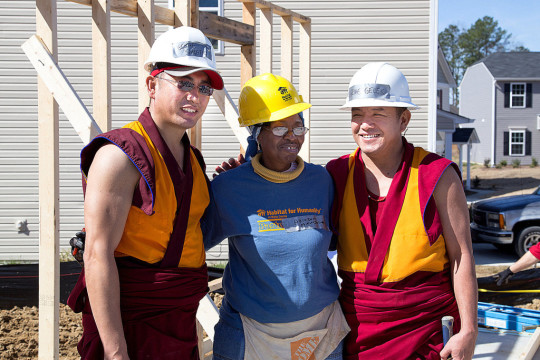
Geshe Sangpo and Geshe Gelek with future homeowner Abiodun Akinsola, North Carolina, US, March 2015. Photo by David Strevel.
Student Elise Strevel from Kadampa Center in Raleigh, North Carolina, in the United States recently sent Mandala news about the center’s interfaith work with the non-profit organization Habitat for Humanity:
Geshe Gelek Choda and Geshe Palden Sangpo, resident teachers for the Kadampa Center for the Practice of Tibetan Buddhism, kindly and happily participated in a Habitat for Humanity Interfaith Coalition Faith Leaders’ Wall Raising on March 12, 2015.
They represented the Buddhists from Kadampa Center, one of eight different faiths from 20 different faith communities, which also included Baha’i, Christianity, Hinduism, Judaism, Islam, Sikhism, and Unitarianism. The faith leaders came together to bless this first day of construction and to represent the support of their memberships.
The home is being built for Abiodun Akinsola and her sons, who are from Nigeria. Habitat for Humanity of Wake County empowers people who qualify to build and buy their own homes. To be chosen, the family must contribute 250 hours of “sweat equity” to the build, and be able to pay a modest down payment and monthly mortgage.
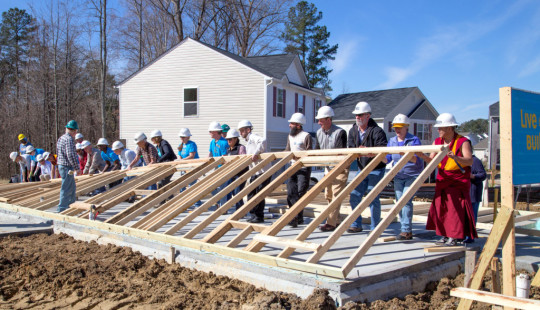
Twenty communities representing eight faith traditions worked together to raise the walls of the new home, North Carolina, US, March 2015. Photo by David Strevel.
Geshe Gelek and Geshe Sangpo are accustomed to hard work and had participated in lots of construction for their monastery in India. However, they had no experience with board and nail construction, which is the way this house is being built. They needed instruction on how to hammer in a nail and use the power saw and drill. They both learned very quickly and in less than an hour they were working like professionals! Others were impressed with their industriousness and careful work.
The construction of this home had special meaning because of the recent murder in North Carolina of three Muslim students – Deah Barakat, Yusor Abu Salha, and her sister Razan – who were volunteers with Habitat for Humanity. Plans were announced for another Habitat home that will be built in their honor in Wake County in May and one in their native land of Jordan.
Mandala brings you news of Lama Zopa Rinpoche and of activities, teachings and events from nearly 160 FPMT centers, projects and services around the globe. If you like what you read on Mandala, consider becoming a Friend of FPMT, which supports our work.
- Tagged: community service, interfaith, kadampa center
- 0
2
Moscow Prepares to Meet Lama Zopa Rinpoche
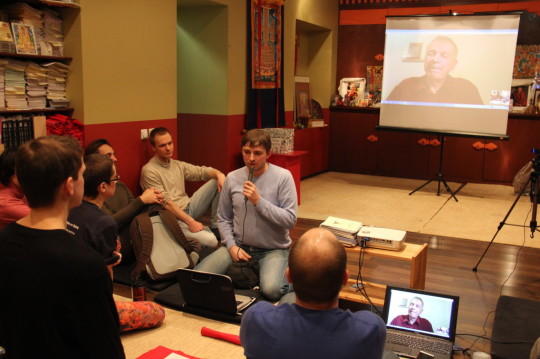
Students of Ganden Tendar Ling receive preparatory teachings from Andy Wistreich for Lama Zopa Rinpoche’s July visit, Moscow, Russia, February 2015. Photo courtesy of Ganden Tendar Ling.
Maxim Severin from Ganden Tendar Ling in Moscow shares with Mandala how the center is preparing for Lama Zopa Rinpoche’s July 2015 visit:
We would like to share the greatest news: Lama Zopa Rinpoche agreed to come to Moscow during July 1-5. He will give teachings on the three principal aspects of the path. Last time Rinpoche came to Moscow was back in 2003. We are overwhelmed with joy and happiness! Our preparations are in full swing and we aspire to arrange the visit the best we can so that Buddhists from all over Russia and other countries can come and benefit from the teachings.
We started a program called “Meeting Lama Zopa.” Andy Wistreich, a well-known British FPMT registered teacher gives lectures on how to relate to the spiritual teacher in an unusual format – via Skype! Basing his talks on the book The Heart of The Path by Rinpoche, Andy speaks with energy and with a very special warm humor about the importance and responsibility of choosing your guru; how to establish and maintain spiritual ties with him; and how to build respectful, caring and compassionate relations with people in a secular society. He tells us about his own relationship with Rinpoche.
We have translated the book The Heart of The Path into Russian and wish to publish it by his visit. Everybody wishing to help Russian speakers read this crucially important book is welcome to contribute to its publication.
Mandala brings you news of Lama Zopa Rinpoche and of activities, teachings and events from nearly 160 FPMT centers, projects and services around the globe. If you like what you read on Mandala, consider becoming a Friend of FPMT, which supports our work. For more on upcoming teaching events with Rinpoche, see Rinpoche’s schedule on FPMT.org.
- Tagged: ganden tendar ling, russia
- 0
- Home
- News/Media
- Study & Practice
- About FPMT Education Services
- Latest News
- Programs
- New to Buddhism?
- Buddhist Mind Science: Activating Your Potential
- Heart Advice for Death and Dying
- Discovering Buddhism
- Living in the Path
- Exploring Buddhism
- FPMT Basic Program
- FPMT Masters Program
- FPMT In-Depth Meditation Training
- Maitripa College
- Lotsawa Rinchen Zangpo Translator Program
- Universal Education for Compassion & Wisdom
- Online Learning Center
- Prayers & Practice Materials
- Overview of Prayers & Practices
- Full Catalogue of Prayers & Practice Materials
- Explore Popular Topics
- Benefiting Animals
- Chenrezig Resources
- Death & Dying Resources
- Lama Chopa (Guru Puja)
- Lama Zopa Rinpoche: Compendium of Precious Instructions
- Lama Zopa Rinpoche: Life Practice Advice
- Lama Zopa Rinpoche Practice Series
- Lamrim Resources
- Mantras
- Prayer Book Updates
- Purification Practices
- Sutras
- Thought Transformation (Lojong)
- Audio Materials
- Dharma Dates – Tibetan Calendar
- Translation Services
- Publishing Services
- Teachings and Advice
- Find Teachings and Advice
- Lama Zopa Rinpoche Advice Page
- Lama Zopa Rinpoche: Compendium of Precious Instructions
- Lama Zopa Rinpoche Video Teachings
- ༧སྐྱབས་རྗེ་བཟོད་པ་རིན་པོ་ཆེ་མཆོག་ནས་སྩལ་བའི་བཀའ་སློབ་བརྙན་འཕྲིན།
- Podcasts
- Lama Yeshe Wisdom Archive
- Buddhism FAQ
- Dharma for Young People
- Resources on Holy Objects
- Ways to Offer Support
- Centers
- Affiliates Area
- Teachers
- Projects
- Charitable Projects
- Make a Donation
- Applying for Grants
- News about Projects
- Other Projects within FPMT
- Support International Office
- Projects Photo Galleries
- Give Where Most Needed
- FPMT
- Shop
Subscribe to FPMT News
Translate*
*powered by Google TranslateTranslation of pages on fpmt.org is performed by Google Translate, a third party service which FPMT has no control over. The service provides automated computer translations that are only an approximation of the websites' original content. The translations should not be considered exact and only used as a rough guide.My religion is kindness to all







